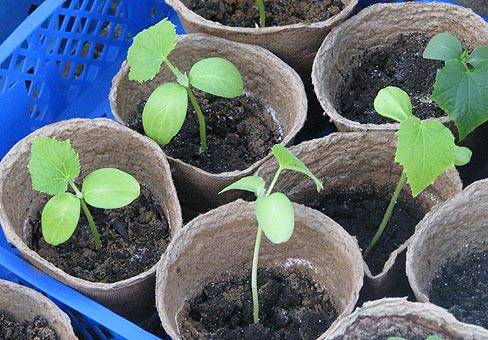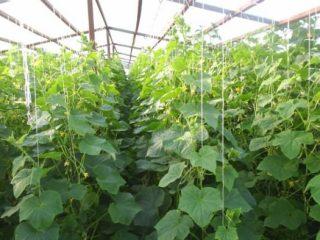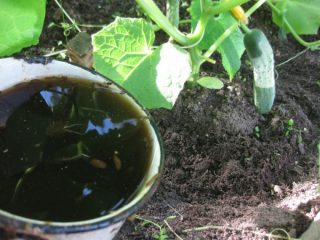Content
When cucumbers grow poorly in a greenhouse, you need to decide quickly what to do. The choice of one or another method of eliminating the problem depends on the cause of this phenomenon. Cucumbers are a capricious crop, so some agrotechnical mistakes lead to a minimal and poor-quality harvest. This fact upsets the owners of summer cottages. Some may refuse to further grow cucumbers in a greenhouse; more stubborn gardeners will find the reason and try to eliminate it.
Reasons for poor growth of cucumbers
There are several factors that negatively affect the future harvest. The main reasons for the decrease in the yield of cucumber plants:
- lack of nutrients in the soil;
- infection with fungal diseases;
- incorrect selection of seed material;
- injury to plant roots during transplantation of seedlings;
- thickening of plantings;
- mismatch of temperature and light conditions;
- violation of the watering regime;
- a large number of ovaries and shoots on the bushes;
- excess nitrogen compounds in the soil;
- pest damage.
Soil fertility constantly decreases over time, so it is necessary to regularly add special additives to the soil. It is advisable to change the soil in the greenhouse every 2-3 years.To do this, remove the top layer (about 25 cm), and replace it with fresh soil mixed with humus, peat and sand.
It is important to feed plants periodically, especially when planting in infertile or infertile soil. You can make the first addition when sowing seeds or planting seedlings. To do this, mix a little humus into the prepared holes.
As soon as the seedlings take root, it is recommended to water them with a solution of liquid mullein, taken at the rate of 1 liter per bucket of water.
To increase fertility, it is necessary to use complex mineral fertilizers.
Infection with fungal diseases is another reason for poor bush growth. First, the fungus attacks the soil, and then the plants themselves. As a result of exposure to infection, the death of the entire crop is possible.
To prevent infection, it is necessary to pre-disinfect the soil substrate. To do this, it is spilled with a saturated solution of potassium permanganate; it is better to do this before planting cucumbers.
When growing cucumbers in a greenhouse, it is important to understand that pollination by insects is difficult indoors. Therefore, they usually take self-pollinating varieties; the bag with this type of cucumber is marked F1. Such seed material is of higher quality, but it must first be sorted, removing infertile seed. The germination test is carried out in a 5% saline solution; seeds that have settled to the bottom are taken for planting. Before sowing, they will have to be soaked in appropriate compounds and treated with growth stimulants.
How to identify and eliminate the causes
To prevent damage to the roots, it is better to sow the seeds immediately on a prepared bed.It is convenient to grow seedlings in organic containers, which are then planted with the plant. You can also use individual dishes from which the sprouts will be removed along with a lump of earth.
When plantings are dense, plants begin to compete for nutrients, water and light. There is a high probability of oppression of weaker plants. Poor ventilation and lack of light also lead to crop loss. To prevent this from happening, it is necessary to maintain a distance between bushes in a row of at least 20 cm, and between rows - from 60 cm.
When growing cucumbers in a greenhouse, it is important to control the temperature. Optimal temperatures are + 25°C during the day, and at night – no lower than +15°C. Temperatures below +15°C have a negative effect on the formation of ovaries and plant growth. Those who are wondering why cucumbers grow with crochets in a greenhouse need to pay attention to this fact. Exceeding the norm of +30°C prevents normal fertilization, and the harvest becomes smaller.
In hot weather during the day, it is necessary to shade the sprouts from the scorching rays.
On cold nights, you will need to create additional heating for the plants. For this purpose, plastic containers, buckets and barrels filled with hot water are used. You can water the soil with warm water in the evening.
Cucumbers are a light-loving crop, so it is necessary to provide them with optimal lighting. If there is not enough light, then artificial lighting must be used. It is important to water the plants abundantly at intervals of 2-3 days with warm liquid, and the water temperature should be approximately the same as the soil temperature.At the same time, excessive moisture should be avoided, as this can lead to the formation of rot on the roots, diseases and subsequent death of the plants. Varieties that have wide leaves, which evaporate large amounts of moisture, especially need water. Lack of water negatively affects the taste characteristics of the fruit.
If a large number of ovaries and shoots are formed on the bush, you need to take care of timely shaping. It is not necessary to pluck off excess shoots from varieties growing in one stem and hybrids with limited growth of lateral shoots.
Excess nitrogen compounds and pest damage
With an excess of nitrogen, all the plant’s energy goes into the formation of green mass. The leaves become large and bright green, but at the same time a lot of barren flowers form on the plant. Excess nitrogen leads to a lack of phosphorus and potassium, which are responsible for the quantity and quality of the crop.
If symptoms of excess are detected, the plant should be fed with a potassium-phosphorus additive and ash. To prevent overdose, it is necessary to monitor the amount of nitrogen fertilizer applied.
To control pests, insecticides or traditional methods are usually used - soap solution, infusion of garlic arrows or onion peels. In order not to wonder why cucumbers grow poorly in a greenhouse, it is necessary to follow all agrotechnical rules for growing this crop. When planting seedlings, it is important not to delay this process. Month-old sprouts are most often planted in the ground; in this case, their adaptation will be the best. It is important not to damage the root system. When growing cucumbers in a greenhouse with seeds, do not forget to warm the soil, otherwise the seed material may rot.It is best to sow in warm weather.
If the fruits of cucumbers grow poorly in a greenhouse, and the plants themselves begin to lag in growth, it is important to correctly identify the cause and take appropriate measures. Timely harvesting will also help improve the development and growth of fruits. If ripe fruits are not removed in time, the ovaries may die.






















